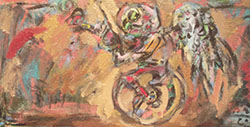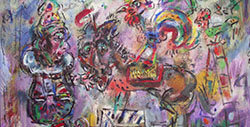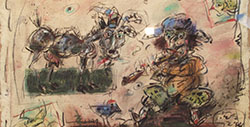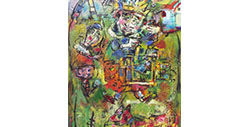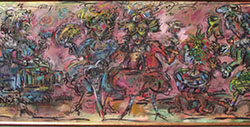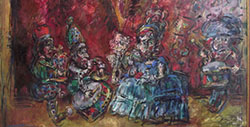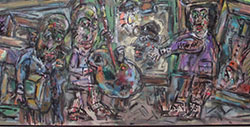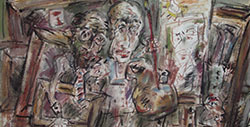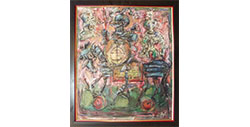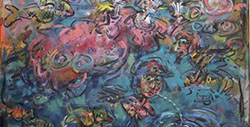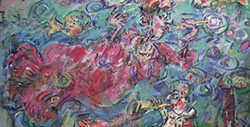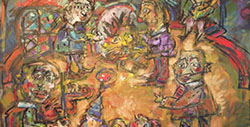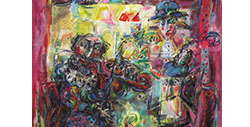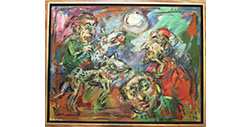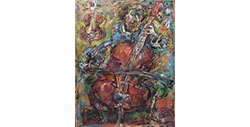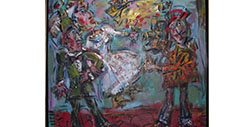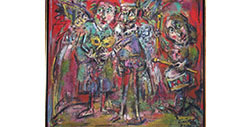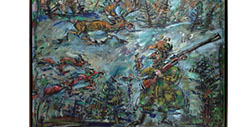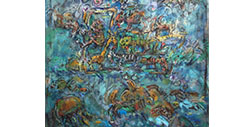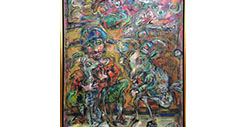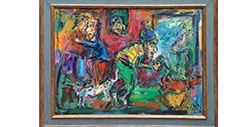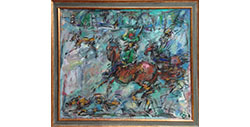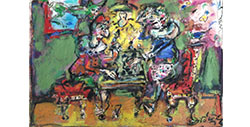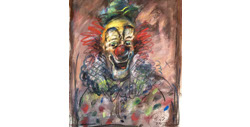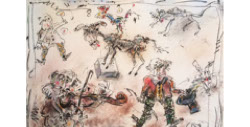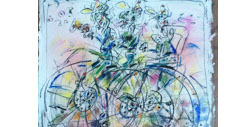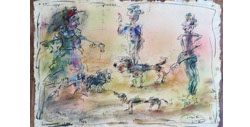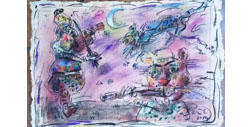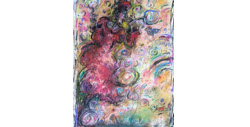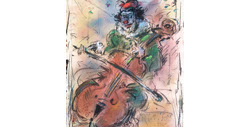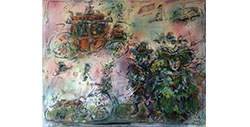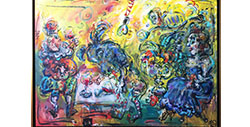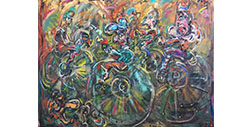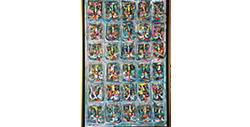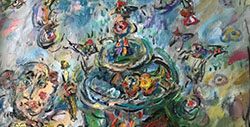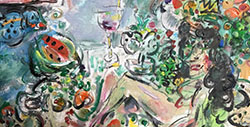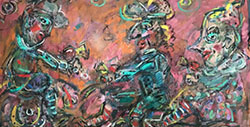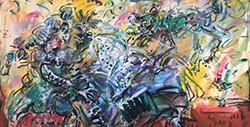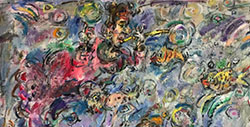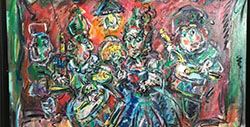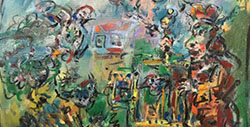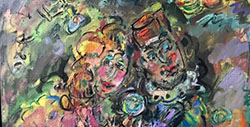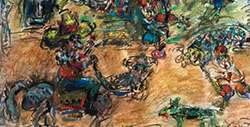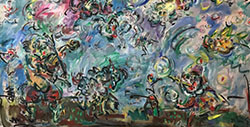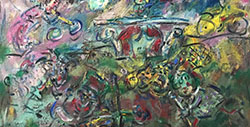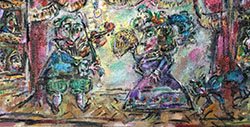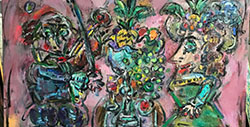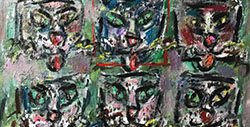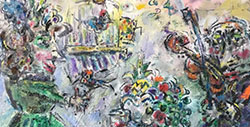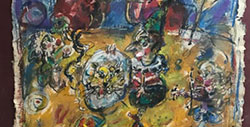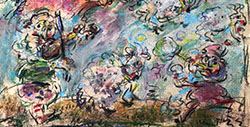My paintings
- "It is hard to decide which world is real. The one we live in, or the one we see in a dream."
János Sturcz
The Praise of Silliness - Ernő Tóth's Paintings
Ernő Tóth made a rather interesting detour in the jungle of arts. At the Secondary School of Arts he majored in sculpture, then, at the Academy of Fine Arts he studied painting from Iván Szilárd, who followed the traditions of the famous Hungarian painter István Szőnyi. After graduation he worked as a scenery-sculptor at the Hungarian Opera House for several years, where he painted lyrical scenes based on large, pictorial patches. Whereas during the last 5-10 years he ended up at drawing in his paintings, and also calls his sculptures three-dimensional drawings. Yet, one of his paintings displayed here,k the first picture of the exhibition entitled Clown with a Chameleon from 1991 clearly shows that he has a very good sense of colour, gestures, large scales, and of even more heroic expression His clown is drawn in a childish style, yet he suggests power, as he is a monumental figure burning in a visionary, mythical fire. As his hand reaches for the chameleon with its ever-changing colours, he recalls William Blake's associations and the strong, almost violent pictorial features of the COBRA group, especially Karel Appel. In spite of all this, in the past 15 years Ernő Tóth has chosen the graphic style. Moreover, he decided to use genres such as caricature, narrative and grotesque, which were so much despised in modern times, then re-valued in the post-modern. The thousands of tiny creatures and details in his perpetuum mobile must have been inspired by his own vibrating, excitable personality a kind of feeling of the horror vacui. In addition, the motivation might also have been our petty, selfish and violently pushy age that is falling into its atoms. As a result, Ernő Tóth covered his canvases and papers with the continuous bustle of his figures, who commit all the human sins intemperance, lie, arrogance, silliness, boasting, hypocrisy, kowtow with all-out effort, yet they are expressed with love and humour. His view is basically determined by the theatre and the circus, as all his works of art are kinds of scenes from the commedia dell' arte, they are parables and fables. In his pictures one can find the characters of a big fairy tale book or a secret garden: mainly clowns, bogeymen, Don Quijote, Munchausens, beautiful ladies and personified animals walk up and down and play parts from scene to scene, thus representing the silliness of mankind. The main character of his paintings is the clown dressed in a striped costume, whse stumbling figure may suggest some kind of a self-portrait. This self irony indicates that unlike James Ensor, forerunner of grotesque views and usage of masks, yet despising mankind, Ernő Tóth does not treat his characters in a nasty way. Instead of judgement he applies a kind of understanding love to depict the acts that are often senseless or reprehensible. He can clearly see that one is not able to learn from others' mistakes, not even from their own ones and it is pretty obvious that "we are all a bit burnt food" as the Hungarian writer Béla Hamvas put it. Ernő Tóth turns the most absurd deed into a jolly carnival or ball scene, or even a harvest feast. One of his frequently returning topic is the tale that ridicules human ambitiousness, The Musicians of Bremen, which in accordance with the title of the exhibitions the audience can see both in the forms of painting and sculpture. The pyramid of the animals is difficult to build. On one side a clown is enticing the donkey with some straw, while on the other side another one is pushing the bottom of the stubborn mule, and the lean-flanked cat jumps into its place at the last moment. The creation of the formation is not the result of the clumsy human's will instead it is due to the magic power of the goat playing the violin. That often returning motive seems to be the caricature of Marc Chagall's violinists, who influenced Ernő Tóth's pictorial world. In the foreground in the role of the ringmaster one can recognise Danny de Vito, who arrived at the scene from Tim Burton's film, Big Fish. The jolly, visionary bubbles surrounding the swinging, juggling clowns with heart-shaped legs are also from that film. Many of Ernő Tóth's works were inspired by films and music. The most important one is Fellini's Clowns, which affected the major figure in Ernő Tóth's iconography: the clown. It is rather interesting that Ernő Tóth's bard does not follow the types usual in the commedia dell' arte or at the circus. They combine the features the white-faced, fooled Pierrot and the colourfully dressed Harlequin, who supports the black-faced Scarpino playing the role of the devil. He is a deceiving, yet still more of a deceived lover at the same time. Such cheated figures are shown in the painting that caricatures the ravenous consumer society. The title is: Who can take more? The picture depicts the doubled figures of two clowns, who are about to burst as they are having a dumpling eating competition. "I am at my wit's end as I eat and eat and" sang Laca fe Lugossy in the alternative group called Bizottság, yet the famous guzzling scenes from the Hungarian film The Watch-Box is Leaving, are also depicted in the background of this multicoloured picture. The novelty here lies in the very up to date contents. It is not the greed of the manipulated customers that gives us an aversion it is rather the whispering-grinning kibitzers behind them, who manipulate and persuade them. It is the shiftiness and vileness of the media and PR serving the capital that would disgust us.
In his painting entitled Would You Like a Glass of Water? Ernő Tóth draws the attention to the dangers of the consumer idiotism exploiting the environment in a rather playful, humorous way. In this picture a clown is taking water for a goldfish put in fish tank. Art is certainly never just the message of the topic, but it is also a game with the artistic means and devices. Although Ernő Tóth emphasises drawing in his works, I would also like to draw the attention to the picturesque reflection on the surface of the water in the fish tank, which recalls the art of Béla Czóbel, Jean Dubuffet and Karel Appel. This clearly shows how Ernő Tóth can keep the joy of playing with colours, even if he has restricted himself into a narrow area within the graphic art. Getting back to that pair of clowns, he also gives an answer to the question why these sweet scamps can be deceived so easily. In his painting depicting clowns playing chess he expresses their stupidity: one of them is narrow-minded and short-sighted, which characters are represented by how closely he is watching the chess piece. The other is a Don Quijote look-like figure, who is thinking with a gesture that recalls Winnie-the-Pooh. Such guys can be cheated very easily! Besides representing both the current and the constant human features, clowns are also very good figures for Ernő Tóth to play with the topic of the great figures in art history, but in a more lyrical, more melancholic and in a somewhat dramatic way. A good example is the Prodigal Son, whose father recalls Rembrandt's figure combined with Picasso's clown king, painted in the painter genius' old days. Of course, the prodigal son is a clown, and since the father is a painter, the home-coming son provides a hidden self-portrait here. Under the pale sun a ladder appears symbolising transcendence and the desire for spiritual purification. The figure spying in the background is again a form of the manipulator and trouble maker customary in Ernő Tóth's paintings.
Animals have very important roles in Ernő Tóth's paintings. The singing bird in the Prodigal Son symbolises the joy over getting back to the right path. Whereas, the sympathising dog with a bent head does not only represent faithfulness and devotion, but also shows the painter's experience about and love for his hounds, that he is so proud of. (Please forgive my telling intimate details about you, but it is so characteristic of Ernő Tóth, that he regularly goes hunting with his dogs, but he never takes a gun in his hand.)
The goat is also a frequent character in Ernő Tóth's paintings. It is the exhibitionist caricature of male arrogance and lust for power. Again, paintings and sculptures show an interesting difference here. While the three-dimensional variation represents the hero as a king showing off his risqué genitals, the drawing depicts a ranting petty bourgeois, who is wearing tracksuit, sitting in his armchair watching TV, as the female members of his family are lionizing him. As well as other animals, the goat has a biographical origin in Ernő Tóth's art. He had a wonderful childhood, when they lived in a suburban part of Miskolc, where they had all kinds of animals in the garden. And Ernő Tóth could have his own little goat. The clown's figure is also rooted in his childhood. As a little boy Ernő Tóth got a bogeyman mask from his mother as a gift. Is it possible, that this good-boy adult was bad as a child? All in all, the identification with the mask and the role led him to his devil figures, who recall naughty kids rather than evil creatures.
In his art world filled with thousands of small figures, children, putti, fairy tale characters, animals and drawings Ernő Tóth probably tries to extend that happy childhood. In professional terms I could say that he joins the movement of Hungarian art that follows Lajos Gulácsy, György Román, Ilka Gedő, Tamás Lossonczy and goes parallel with Péter Újházi, Péter Földi, Árpád Szabados, Ferenc Banga and others. Their aim is to use children's drawings in order to find the way back to the clean area of the human soul, which people all lose by the time they grow up, and which could be the best means to ease the stressful experiences with the help of humour.
Dear Ernő, I wish you more undiminished and happy infantilism to work and to extend your childhood!
